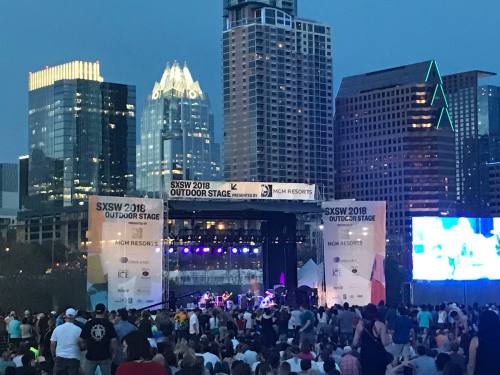While South by Southwest Conferences & Festivals brought profits to bars, restaurants and hotels downtown, its reach has not always been felt as strongly in North and Northwest Austin.
“I don’t look forward to South By any year because there’s no real benefit for us,” said Jeff Van Delden, co-founder of Union Venture Group, which operates several Domain Northside bars, including The Rose Room and Jack & Ginger’s Irish Pub.
Hotels in The Domain area do see an increase in visitors; however, visitors tend to spend most of their time downtown, Van Delden said.
“It’s similar to an average week,” he said. “We’ll lose some people that are participating in the festival, but we’ll gain some people that are locals. “
Citywide, SXSW reports an enormous impact on Austin—to the tune of $350.6 million in 2018, according to a report by Greyhill Advisors, a firm hired by SXSW to develop economic impact reports.
Records from the Texas Comptroller of Public Accounts indicate some downtown businesses see monthly revenue in March increase by 40 to 50 percent above their average revenue per month for 2018. North and Northwest Austin businesses see more modest gains.
“All my friends and counterparts that own other restaurants and bars that are downtown experience phenomenal sales,” Van Delden said.
With increased traffic, an influx of visitors and skyrocketing prices, SXSW is more than a 10-day hiccup downtown. It mirrors the changes Austin is experiencing as its population, economy and tech sector continue to grow. Some business owners see that as an opportunity for the festival’s impact to expand beyond the city’s center.
“We’d love to have more out-of-towners because when we get them, such as football teams [competing in Austin], they come back every year,” said Tommy Kerbow, manager of Northwest Austin restaurant Catfish Parlour.
A barometer for change
In 1987, when SXSW started, it was a local stage for undiscovered musicians in a city of just over 461,000 people. Now, 32 years later, SXSW is an internationally known music, film, gaming, education and technology conference. The city of Austin—with a population today of nearly 1 million—is becoming increasingly known as a tech and startup hub.
Apple, Samsung, Google and others have launched campuses locally, some in Northwest Austin.
“Events like SXSW help put the flag in the ground for Austin to say this is a place that attracts that kind of human capital,” said Michael Sury, a finance lecturer at The University of Texas.
In 1994, when Multimedia—as Interactive was then called—first debuted at SXSW, it struggled to draw a crowd, the event’s Chief Programming Officer Hugh Forrest said. Now Interactive, the technology aspect of the festival, has furthered Austin’s brand as a tech city.
“Tech is more of the breadwinner of the family, and Music has struggled a little,” Forrest said.
The emphasis on tech helped position Austin as a city of the future, Forrest said. As the festival prospered and grew over the decades, so too, has the city.
“So far, we’ve seen the growth of SXSW correlate almost one for one with the growth of the economy in the city,” Sury said.
Van Delden said although he collaborates well with North and Northwest Austin-area tech companies on events and parties throughout the year, the festival has historically drawn their attention downtown during March.
“I think when South By comes around they take that as an opportunity to do something different than what they normally do,” he said.
Economic impact
Attendance exceeded 75,000 people in 2018, according to the economic impact report. Many stayed at Austin-area hotels at an average rate of nearly $400 a night and ate at local restaurants and bars.
“[Festival attendees] are pumping so much money into the economy that it really does benefit [locals],” Sury said. “This money stays in the city of Austin.”
Hotels booked through SXSW alone contributed $1.8 million in hotel occupancy tax funds, according to the 2018 report from Greyhill Advisors.
While tax revenue gets allocated throughout the city, the increased revenue that businesses experience in March is more concentrated downtown.
“I don’t think many SXSW people want to stay this far out,” Kerbow said. “If it didn’t exist, I wouldn’t even know.”
Looking to the future
The economic impacts are not entirely isolated downtown, economists say. Hotels book up throughout the area—from Round Rock to San Marcos, and attendees typically spend money near where they stay, Sury said. However, business owners outside the festival hub do not always see direct gains on their ledgers, he said.
As a former owner of a downtown bar, Van Delden said he knows the impact SXSW events can have on businesses.
“All of my Domain counterparts feel left out,” Van Delden said. “It’s such a big area of the city that has no connection to the festival.”
For now, he said he hopes SXSW event organizers will look northward.
“We’re lucky enough on Rock Rose [Avenue] in Domain Northside to be able to block off the street for fesitval and concerts,” he said. “... I’m sure if there was interest from SXSW people we could have concerts in the vicinity that everybody could enjoy,” he said.
If and when that expansion happens, Kerbow said he thinks it could benefit local businesses such as his.
“If SXSW were to grow up north, I would welcome it,” he said.








